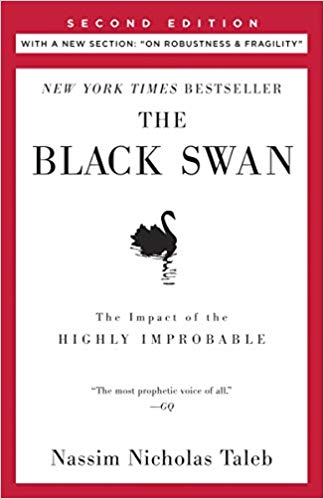

This article is an excerpt from the Shortform summary of "The Black Swan" by Nassim Taleb. Shortform has the world's best summaries of books you should be reading.
Like this article? Sign up for a free trial here .
Does the bell curve accurately describe the world? When does the bell curve work, and when does it fail? How can we make better predictions and more accurately describe the phenomena of real life?
We’ll cover the situations in which the normal bell curve distribution is a good predictor of the real world, the situations where it’s not, and better ways to represent randomness in an uncertain world.
Extremistan vs. Mediocristan
Before we look at how the bell curve describes the world, let’s look at Nassim Nicholas Taleb’s Extremistan and Mediocristan. To explain how and why Black Swans occur, Taleb coins two categories to describe the measurable facets of existence: Extremistan and Mediocristan.
In Mediocristan, randomness is highly constrained, and deviations from the average are minor. Physical characteristics such as height and weight are from Mediocristan: They have upper and lower bounds, their distribution is the bell curve, and even the tallest or lightest human being isn’t much taller or lighter than the average. In Mediocristan, prediction is possible.
In Extremistan, however, randomness is wild, and deviations from the average can be, well, extreme. Most social, man-made aspects of human society—the economy, the stock market, politics—hail from Extremistan: They have no known upper or lower bounds, their behavior can’t be graphed on the bell curve, and individual events or phenomena—i.e., Black Swans—can have exponential impacts on averages.
Imagine you put ten people in a room. Even if one of those people is Shaquille O’Neal, the average height in the room is likely to be pretty close to the human average (Mediocristan). If one of those people is Jeff Bezos, however, suddenly the wealth average changes drastically (Extremistan).
Forget Heisenberg
When discussing uncertainty, experts will frequently invoke physicist Werner Heisenberg’s uncertainty principle. In its specific application, the uncertainty principle holds that the more precisely one measures the position of a given particle, the less precisely one can measure its momentum, and vice versa.
The problem with this analogy is that subatomic uncertainty actually hails from Mediocristan—particles’ deviations from their expected positions or momentums can be graphed using the normal bell curve, and the sheer number and tininess of particles in existence mean those mild deviations average out.
Real uncertainty arises in the real world—like, for example, when Taleb can’t reach his ancestral village in Lebanon from New York because Israel is battling Hezbollah.
The Limits of the Bell Curve
The classic normal bell curve—which is also called the “Gaussian distribution” after German mathematician Carl Friedrich Gauss—is an accurate description of Mediocristan phenomena, but it is dangerously misleading when it comes to Extremistan.
Consider human height, an eminently Mediocristan phenomenon. With every increase or decrease in height relative to the average, the odds of a person being that tall or short decline. For example, the odds that a person (man or woman) is three inches taller than the average is 1 in 6.3; 7 inches taller, 1 in 44; 11 inches taller, 1 in 740; 14 inches taller, 1 in 32,000.
It’s important to note that the odds not only decline as the height number gets further and further away from the average, but they decline at an accelerating rate. For example, the odds of someone being 7’1” are 1 in 3.5 million, but the odds of someone being just four inches taller are 1 in 1 billion, and the odds of someone being four inches taller than that are 1 in 780 billion! Human height can be accurately graphed on the bell curve.
Now consider an Extremistan phenomenon like wealth. In Europe, the probability that someone has a net worth higher than 1 million euros is 1 in 62.5; higher than 2 million euros, 1 in 250; higher than 4 million, 1 in 1,000; higher than 8 million, 1 in 4,000; and higher than 16 million, 1 in 16,000. The odds decrease at a constant, rather than accelerating, rate, indicating that their distribution doesn’t conform to the normal bell curve.
(Note: The European wealth statistics cited above aren’t precise, but they illustrate the central point: that wealth is scalable and does not look like a bell curve distribution.)
The upshot is that in Extremistan, as the name suggests, extreme events have much better odds of occurring than in Mediocristan. Simply put, the bell curve does not apply.
The Mistakes of Adolphe Quételet and the Misuse of the Bell Curve
Adolphe Quételet (1796–1874) was a French mathematician who developed the idea of the “average human” (l’homme moyen) through the use of “means”—golden averages that represented the ideal human form.
At first, his inquiries were limited to human beings’ physical characteristics—height, weight, newborn weight, chest size—but before long, he began to seek averages in the social realm by studying human habits and morals. Quételet developed bell curve distributions to describe humans’ deviance—literally—from both physical and moral norms.
Although Quételet’s ideas were influential in his historical moment, there were skeptics. Augustin Cournot, a fellow mathematician and philosopher, pointed out that social averages would necessarily depend on exactly whom and what attribute was being studied. An obvious example is human diet: If you were trying to determine the amount of seafood an average human consumes, you might get vastly different measurements if you were surveying inland populations versus coastal ones, or populations whose cultural traditions included a seafood-heavy diet.
In our contemporary moment, the most egregious misuse of normal bell curves can be found among economists and financial-industry analysts. Most economists, including many Nobel Prize–winners, treat financial markets as though they hail from Mediocristan when, in fact, they’re from Extremistan.
A stunning example of economists’ misinterpretation of the market came in 1998, with the collapse of Long-Term Capital Management (LCTM), a hedge fund that included among its founding partners two Nobel Prize–winners, Myron Scholes and Robert C. Merton (Robert K. Merton’s son). Scholes and Merton won their Nobel Prize for a theory of stock option pricing; the theory, however, was based on a Gaussian model of the market that excluded the possibility of Black Swans.
When markets were disrupted by the Asian financial crisis of 1997 and the Russian financial crisis of 1998—a one-two punch of Black Swans—Scholes and Merton’s theory was revealed for the fantasy it was. The twin crises resulted in a crushing $4.6 billion loss for LCTM in fewer than four months. The firm had to be bailed out by a consortium of private banks, at the behest of the Federal Reserve.
The problem is that economists’ models are thoroughly Platonified: self-consistent, but bearing almost no resemblance to reality. Economists are like philosopher John Locke’s madmen: they reason “correctly from erroneous premises.” The bell shaped curve isn’t always the best tool.
Representing Randomness: Fractals and Power Laws
We’ve seen that the bell curve distribution doesn’t always accurately represent the world. So can the phenomena of Extremistan be modeled—and thereby predicted—at all? Not precisely; but they can be approximated—by the use of fractals. The reason fractals are helpful in representing Black Swans is that their internal ratios stay constant across scales. Unlike bell curves, in which ratios decline at accelerating rates the further one gets from the average, fractals exhibit no (or mild) acceleration. They obey power laws, which describe a functional relationship between two quantities in which the relationship remains constant no matter what the initial size of the quantities.
———End of Preview———

Like what you just read? Read the rest of the world's best summary of "Black Swan" at Shortform . Learn the book's critical concepts in 20 minutes or less .
Here's what you'll find in our full Black Swan summary :
- Why world-changing events are unpredictable, and how to deal with them
- Why you can't trust experts, especially the confident ones
- The best investment strategy to take advantage of black swants






